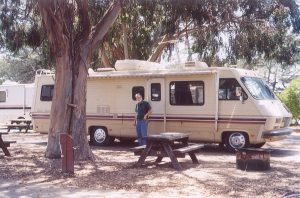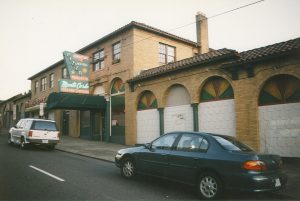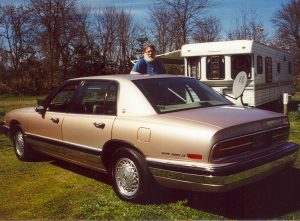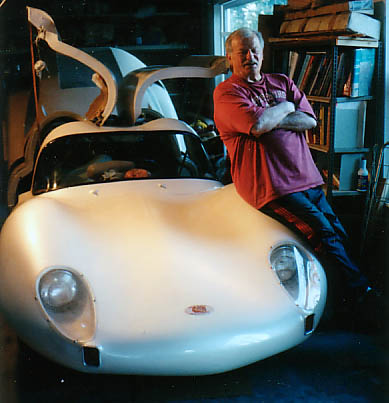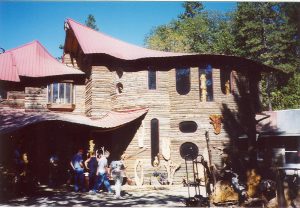In March of 2000 we abandoned our huge, wonderful apartment above the Monte Carlo with the view of downtown Portland and moved into quarters small enough that Amnesty International would howl if Saddam Hussein imprisoned two Iraqis in it: i.e., a 35-foot travel trailer. It seemed a good idea at the time. Actually, it still seems like a good idea, except that things didn’t get moving as quickly as we would have liked. During the 2 years we spent on Sauvie Island it became clear that we didn’t want to tow a travel trailer, so we sold it and bought a 34-foot 1984 Pace Arrow Class A Recreational Vehicle.
If a school bus screwed a bungalow, the bastard offspring would look a lot like what we call a Class A recreational vehicle. The American RV combines some of the advantages of both bus and bungalow, but it also keeps all of the disadvantages. Imagine that your home had a big engine, an automatic transmission, and a drive train, not to mention all those peripherals that cause so much trouble: fuel pump, radiator, hoses, belts, starter, 6 big tires. Or, try to visualize the family car with a kitchen and bathroom.
Our RV has a full kitchen, with stove, refrigerator, microwave, sink, and small appliances stored in various cubbies. It has a toilet and a shower. In addition to the 89-gallon gas tank, there are three other tanks: for fresh water (64 gallons), waste water from the sinks and shower (gray water), and toilet (black water). There are three hefty batteries and a 30-amp plug-in cord to power the lights and outlets. There is a propane tank for the water heater and furnace, and for the fridge when the cord isn’t plugged in. The fridge, in fact, will run on 12-volt DC, 120-volt AC, or propane, and must decide which of these sources to use depending on the situation. There is also a generator to provide 120V power if you aren’t near a hookup. When we pull into a park I must connect the electrical cord, a water hose, a sewer pipe, a telephone line, and a coaxial cable from the satellite dish.
Lots of stuff to go wrong.
We had a taste of it before we ever hit the road. Driving home after we bought the Pace Arrow, the engine began to cough when I hit the accelerator. The RV had been sitting on a lot for a long time, maybe a year or more, and apparently when gasoline sits that long some of it turns into something else (I’ve heard shellac, varnish, and various other theories). Whatever the decay product is, it doesn’t burn well in the engine and may cause damage … which is academic, because it never gets to the engine, it is stopped by the fuel filter (the RV has 2 of them), where it becomes a thick goo that prevents more gas from flowing, hence the coughing and dying.
The metal valve on the toilet was a millimeter away from bursting and spraying water all over the bathroom; we caught it in time and replaced the toilet. The 4-inch plastic pipe that connects the sewer outlet to the flexible sewer hose had a crack in it. This was the only needed operation that fell within my meager mechanical abilities, so I removed and replaced it … a thoroughly foul bit of work that you don’t want to hear anything more about, trust me.
We also had to replace the brake master cylinder.
All that being done, we thought we were in pretty good shape to start on down the road.
Hah.
Just over the top of one of the passes between Roseburg and Grants Pass, everything shut down. The CD stopped playing, the headlights went off, the engine stopped running. I was lucky to be just approaching the Jumpoff Joe Creek exit from I-5; I pulled off the road and looked helplessly at the engine for a while – I do that, knowing I won’t have a clue as to what the problem is – and then we called AAA, greatly relieved to remember that we had upgraded our membership to include the RV a few months previous, else the tow to Grants Pass would have cost us $95/hour.
Naturally, it was a Friday evening. So we sat there for almost an hour, wondering where the name Jumpoff Joe came from.
Our first night in Grants Pass was spent at The Tool Box Motel. That is, we did what they call “dry camping,” staying in the RV without any hook-ups, in the parking lot of The Tool Box Garage.
Dry camping was a learning experience. When you turn on the water without a hose hookup, pressure is provided by a battery-powered pump, which is noisy. It got cold, so we turned on the furnace, reasoning that since it burns propane it wouldn’t run down the batteries. Ah, yes, but the blower is electrical. Early in the morning I checked the battery level and found it was pretty low. I went to start the generator … and found out the batteries were now too low to get the cranky old thing to start. (Meant to get the damn noisy contraption checked and tuned, forgot to.) Lesson: don’t hesitate to start the generator when you need to. It burns about 1 1/3 gallons of fuel per hour, it won’t bankrupt you. And since it takes fuel from the tank at a higher location than the RV engine, it can’t run your tank dry.
Facing Saturday and Sunday in an RV with no power and no means to recharge it, we fled to a motel. For once, our road rule of selecting the cheap motel with the most interesting neon sign failed us. We liked the looks of the Flaming O Inn. (A lot of neon was burnt out; it’s possible the place was called the Flamingo.) It looked like a little piece of Florida plopped down in Southern Oregon. Inside wasn’t so nice, though, and we moved to another motel before our stay in Grants Pass was done.
Three good things came from our long enforced weekend stay. We got to spend the afternoon with Dean Ing, the only guy I know who designed and built his own race car, The Magnum, from the ground up.
The second good thing was Niko, Lee’s first husband’s son by his subsequent wife (his fourth, Lee says!) (which makes Niko hardly related to Lee, but she reasons that since Niko is her children’s half brother, she must be his half stepmom). He’s working as a stagehand at the Shakespeare Festival in Ashland and got us some comped tickets to Who’s Afraid of Virginia Woolf? at the Angus Bowmer Theater. (This is one of the two indoor venues in Ashland, the Elizabethan Theater being the one open to the sky, like Shakespeare’s Globe, and believe me, before evening shows you see a lot of people toting blankets around the streets. Ashland is chilly at night.) It was an excellent performance, and I was amazed to see how much dialog I remembered from seeing the movie a few times many years ago.
The third good thing was a place called “It’s a Burl.” We found it on the way to the Oregon Caves—which we didn’t tour because Lee doesn’t like caves, and squeezing through small, hard spaces isn’t good for my knees – two miles east of Cave Junction. This is a place where some unreformed hippies about our age or a little younger have run absolutely amuck for twenty years or more. They make stuff out of redwood burls, and if you think this is like the Oregon invention of chainsaw art, you’ve got the wrong idea. These creations are wonderful, well worth the high prices. And every inch of the acre or so was covered with entirely too much stuff to see all at once, including at least three tree houses up to four stories tall. The masterpiece is the main house, under construction to replace one that burned down some years ago. It is huge and rambling, and the architect threw away all his rulers and T-squares. There are very few right angles. Interiors are vaulting, supported by twisted, polished tree trunks. A spiral staircase of polished burl leads to a third-floor bedroom by way of a small bridge of clear Plexiglas. The course of the Illinois River is laid out in stone on the floor, between fitted parquetry. (What is the Illinois River doing in Oregon? Same thing as the towns of Milwaukee, Dallas, and even Portland, I guess. Somebody brought the old names along with them.)
If you want to see the house, better hurry. When it’s finished you won’t be invited inside to observe the work in progress, as we were. But even if you can’t see the inside, the exterior is stunning, too. Just the chance to see the front door is worth the trip.
The huge Chevy 454 engine that powers our moving bungalow has a design flaw, according to the mechanic at The Tool Box. Some critical wires are run entirely too close to the hot engine. It was running especially hot going over the passes, and the wires got fried. It also burned out the alternator. We got both things fixed, and eased on down the road … to a point about a mile short of the Siskiyou summit, near the California state line, when the radiator boiled over. After a time spent letting it cool, we started up and made it nervously through the mountains south of Yreka. Luckily, it’s mostly downhill from there to Redding.
Our second night on the road in the RV we parked in an olive grove just across the freeway from the famous Olive Pit in Corning, olive capital of the central valley. All the RV spaces had three gnarled olive trees growing between them, and on the trees were green olives, very bitter tasting.
Next morning the overheating problem was growing worse, so we pulled into an RV garage in Lodi, trying to recall the lyrics to that old Creedence Clearwater Revival song about being stuck in Lodi again. We were stuck for two nights, in a lousy park and then a real nice one. It could have been a lot worse. The garage was booked solid for 3 weeks. It was mostly local people getting work done after a summer of frolics in their elephantine rigs, so the garage people were nice enough to move us to the front of the list, since we were full-timers and on the road with no other address. So far, we’ve found these places to be understanding and accommodating to people in our situation … and so far, come to think of it, we’ve had entirely too many opportunities to test that goodwill.
The mechanic in Lodi replaced a broken radiator fill neck that he said was allowing coolant to blow out, and tightened the fan belt.
… and shortly after that, the engine started coughing again. I knew what it was, but had never replaced a fuel filter before, didn’t know if it might spill gas on me, or begin to spray gas on the road because I’d done it wrong, and couldn’t even find the second, smaller filter among the maze of wires around the engine … so we found another garage in Stockton, and they were kind enough to do the work quickly. No way to tell if we’ve now filtered all the gum out of the gas tank, but I was advised to buy a gas treatment that will obviate the problem, something called Stabil, which I’ve never seen.
We spent the following night in the little town of Coalinga, in an almond orchard. The almonds I could reach around our parking space were quite edible, if a little dry.
The next day there was one more pass to cross before our destination of San Luis Obispo, and it didn’t look that formidable. Be that as it may, a mile short of the top the needle was in the red again and I pulled over and we watched green coolant boil out of the overflow tank. It whistled and groaned like a wounded dinosaur, which I guess it was. So we sat there at the side of the road for an hour, as silver-backed squirrels the size of house cats brazenly approached us and looked us over. Ground squirrels, I guess, as there wasn’t a single tree to be seen for miles and miles. I hope they didn’t sample the spilled antifreeze after we left. I didn’t think of that until it was too late.
We finally pulled into the town of El Paso del Robles, feeling a little shell-shocked, realizing it had taken us 8 days to get here. (It means “The Passage of the Oaks,” as opposed to “Que Pasa del Roblies,” which translates to “What’s the Deal with Those Okies?”) On most maps the town is called just “Paso Robles,” and we’ve learned the locals usually call it “Paso.” Ten miles south is Atascadero, and 20 miles south of that is San Luis Obispo. (I figure we’ll end up calling them ‘Dero and ‘Bispo.) We found quite a nice park a mile out of town. You drive through a small vineyard to get in, and park under old oak trees. Every once in a while an acorn falls off an oak to clank on our roof … or else they’re being chunked by playful squirrels. Our first day I spotted three beautiful woodpeckers on a telephone pole, where they had drilled a big hole. They were black and white, with a brilliant red stripe on the tops of their heads. The Audubon book informed me they were, no surprise, acorn woodpeckers.
Considering all the olives, almonds, grapes, and acorns we’ve lived among, and the fact that the most interesting thing to do around here, so far, is to visit the old Spanish missions that lie up and down the El Camino Real, I’ve thought about calling this RV Our Lady of the Fruits and Nuts.
But we’ll probably stick to what we’ve been calling it since I once causally cursed it, shortly after nursing it to a gas-starved, sputtering halt out on Sauvie Island: The Beast.
Everything around here is SLO. There’s SLO real estate offices and a SLO phone system and a SLO police department. I’m ashamed to admit I didn’t get it at first, and still sometimes read it as “slow,” rather than San Luis Obispo. But it’s appropriate, as most of our journey was made in the slow lane of I-5, passing only the heaviest trucks.
Looks to be lots to do here. We’re 40 miles due east of the Hearst Castle (twice that by the roads I’d have to take to get there). A local theater group is staging “Little Shop of Horrors.” There’s a classic car rally this weekend, and the beginning of next month is the celebration of the return of the migrating monarch butterflies to Pismo Beach, an event sure to be more colorful and interesting than the few pitiful swallows that return to Capistrano these days.
And if things get too dull, we can always drop by the Madonna Inn in SLO, surely the gaudiest hotel in America outside of Las Vegas. Always good for a chuckle.
October 23, 2002
El Paso del Robles, California

